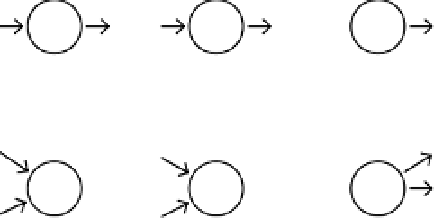Game Development Reference
In-Depth Information
If a pool is trying to pull more resources than exist at the far end of its inputs, it will
handle it in one of two ways:
n
By default, a node pulls as many resources as it can, up to the flow rates of its
inputs. If not enough resources are available, it still pulls those that are.
n
Alternatively, a node can be set to pull all or no resources. In this mode, when
not all resources are available, none are pulled. Nodes that are in
all or none
pull
mode are marked with an & sign (Figure 5.7).
These rules also apply to pushing nodes: By default, a pushing node sends as many
resources as are available out along its output resource connection up to the output's
flow rate. A pushing node in
all or none
mode sends resources only when it can sup-
ply all of its outputs. This means that nodes in push mode might be marked with
both a
p
and an &.
FIGURe 5.7
Pull and push modes
Figure 5.8
illustrates two situations in which there are not enough resources to
meet the demand. Node A is user-activated (which is why you see the double line).
It wants to pull three resources from its upper input and two from its lower one, but
the pools they are connected to do not contain enough resources to do it. When
clicked, node A will simply pull the resources that are available.
When node B is clicked, it tries to pull a random number, from one to six, of
resources from its input. If the random number is four, five, or six, it will pull the
three that are available.
FIGURe 5.8
Two examples showing
fewer resources than
requested











